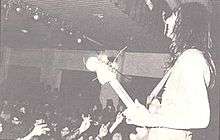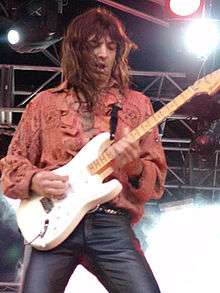Rata Blanca
| Rata Blanca | |
|---|---|
 | |
| Background information | |
| Origin | Buenos Aires, Argentina |
| Genres | Heavy metal, power metal, neoclassical metal, hard rock |
| Years active |
1986–1997 2000–present |
| Website | http://www.ratablanca.net/ |
| Members |
Adrián Barilari Fernando Scarcella Walter Giardino Guillermo Sánchez Danilo Moschen |
| Past members |
Saúl Blanch Gustavo Rowek Sergio Berdichevsky Hugo Bistolfi Gabriel Marian Javier Retamozo Mario Ian |
Rata Blanca (White Rat in English) is a heavy metal band from Argentina formed in 1986.
Biography

The guitarist Walter Giardino replaced Osvaldo Civile in V8 for a little time, and left the band when his songs were rejected. His friend Roberto Cosseddu, bassist of Kamikaze, helped him to record a demo tape with those songs. The drummer Gustavo Rowek, who had also left V8 a short time before, declined his projects with Civile and joined Giardino. The session musicians Rodolfo Cava (singer) and Yulie Ruth (bass player) completed the line-up that recorded the demo. The songs were "Chico callejero", "Rompe el hechizo", "Gente del sur" and "La bruja blanca". Seeking stable members, the band took Saúl Blanch as singer, who was working in the hard rock band Plus. They met the bass player Guillermo Sánchez with the help of Giardino's friend Sergio Berdichevsky, member of WC at that point.[1]
Rata Blanca made their first concert on August 15, 1987 in the Luz y Fuerza theater. Saúl Blanch left the band, and he was replaced by Carlos Périgo, who composed the song "Días Duros". Périgo left the band soon after that. Rodolfo Cava returned for a brief time, and Shito Molina got ill and could not sing anymore. As the band was about to record their first album and needed a singer immediately, Saúl Blanch returned to the band and helped record it. The album Rata Blanca was released in 1988, with nine songs.[1] On that year they took part in the "Halley en Obras" concert, along with Alakrán, JAF and Kamikaze.

Polygram requested that the band could create an album which would have high sales in the first semester to renew the contract, and the band made fourfold the required number of sales. The keyboard player Hugo Bistolfi joined the band in 1989, and the singer Adrián Barilari replaced Saúl Blanch. The band subsequently made their second album Magos, espadas y rosas, which contained the popular songs "Mujer amante" and "La leyenda del hada y el mago". It was a successful release, and in its wake the band appeared in the TV show Ritmo de la Noche, and played in cumbia concert halls because typical rock venues could not accommodate their large audiences.[1]
The album was followed by "Guerrero del Arco Iris", and a concert at the José Amalfitani stadium. The band ended their contract with Polygram recording a live album, made at the Opera Theater with an orchestra,[2] but this album was released years later. Once in BMG they made an EP called "El Libro Oculto". This work was more aggressive, both in instrumental style and lyrical style, as a result of the criticism from heavy metal fans towards the band. Barilari did not like the new style and left the band after a concert in Obras.[1] Bistolfi followed him, and both of them created the band Alianza.
Barilari and Bistolfi were replaced by Mario Ian on vocals and Javier Retamozo on keyboards. With this line-up they released Entre el Cielo y el Infierno ("Between Heaven and Hell"). Later that year, they were invited to play in the "Festival Monsters of Rock" in São Paulo, Brazil, along with Ozzy Osbourne, Therapy?, and Alice Cooper. They released another album with new singer Gabriel Marian called "Rata Blanca VII". The group disbanded in late 1997. Gustavo Rowek and Sergio Berdichevsky created the band Nativo, and Giardino continued with Walter Giardino Temple.
Barilari and Bistolfi were invited to a concert of Walter Giardino Temple in 2000, which led to a reunion of the band. Rowek and Berdichevsky refused to be part of the reunion. The radio La Mega aired frequently the old "Mujer amante" song, generating a renewed interest in the band. The new CD El camino del fuego, released in 2002, was a huge success, and the 2005 CD La llave de la puerta secreta became gold even before being released.[3]
In order to gain a more international profile, Giardino approached former Rainbow singer Doogie White to record an English version of the Forgotten Kingdom album in 2009.[4]
2010 - Present
Early 2010 Rata Blanca historical keyboardist Hugo Bistolfi left the band and was replaced by Danilo Moschen, a former member of Barilari soloist band. In 2013 original members Gustavo Rowek, Sergio Berdichevsky and Saul Blanch reunited with Rata Blanca for some presentations. In 2015 Rata Blanca released Tormenta Eléctrica his tenth studio album.
Personnel
Current
- Walter Giardino: Guitar (1986–1997, 2000–Present)
- Guillermo Sánchez: Bass (1986–1997, 2000–Present)
- Adrián Barilari: Vocals (1989–1993, 2000–Present)
- Fernando Scarcella: Drums (2000–Present)
- Danilo Moschen: Keyboards (2010–Present)
Original
- Saúl Blanch: vocals
- Walter Giardino: guitar
- Guillermo Sánchez: bass
- Gustavo Rowek: drums
- Sergio Berdichevsky: rhythm guitar
Others
- Hugo Bistolfi: keyboards (1989–1993, 2000–2009)
- Mario Ian: vocals (1993–1996)
- Gabriel Marian: vocals (1996–1997)
- Doogie White: vocals on English versions (2009–2010)
- Javier Retamozo: keyboards (1993–1997)
- Saúl Blanch: vocals (1987, 1988–1989)
- Sergio Berdichevsky: rhythm guitar (1986–1997)
- Shito Molina: vocals (1988)
- Rodolfo Cava: vocals (1986)
- Gustavo Rowek; drums (1986–1997)
Discography
Studio albums
- Rata Blanca (1988)
- Magos, Espadas y Rosas (1990)
- Guerrero del Arco Iris (1992)
- El Libro Oculto EP (1993)
- Entre el Cielo y el Infierno (1994)
- Rata Blanca VII (1997)
- El Camino del Fuego (2002)
- La Llave de la Puerta Secreta (2005)
- El Reino Olvidado (2008/2009)
- Tormenta Eléctrica (2015)
Live and compilation albums
- En vivo en Buenos Aires (1996)
- Grandes Canciones (2000)
- Poder Vivo (2003)
- Rata Blanca & Glenn Hughes: A Vivo en Teatro Gran Rex (2003)
Singles
- "La Leyenda del Hada y El Mago"
- "Rata Blanca" (2001)
- "Teatro Gran Rex" (2001)
- "Highway on Fire (EP)" (2002)
Cover versions
Spain's Mägo de Oz recorded a version of "Mujer amante".
References
- 1 2 3 4 Juan Ignacio Provéndola (May 16, 2013). "Rata Blanca: los discos de la buena memoria" [Rata Blanca: The albums of good memoir] (in Spanish). Rolling Stone. Retrieved September 3, 2014.
- ↑ Blanca, Rata (December 1993). "La hora de las Brujas". Madhouse (Interview). Interview with César Fuentes Rodríguez.
- ↑ Sebastian Feijoo (June 1, 2005). "La llave de la puerta secreta" [The key of the secret door] (in Spanish). Rolling Stone. Retrieved September 10, 2014.
- ↑ http://www.doogiewhite.com/news/rata-blanca.htm
External links
| Wikimedia Commons has media related to Rata Blanca. |
- Rata Blanca's official homepage
- biog and discog at MusicMight
- Videoclip: El reino olvidado
- Rata Blanca lyrics